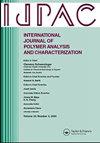从碳灵感到能源创新:环氧纳米复合材料的热和介电性能卓越
IF 1.6
4区 工程技术
Q4 POLYMER SCIENCE
International Journal of Polymer Analysis and Characterization
Pub Date : 2025-02-25
DOI:10.1080/1023666X.2025.2466582
引用次数: 0
摘要
近年来,聚合物电介质已经彻底改变了几个电气和相关领域。变压器作为感应装置,会产生大量的热量,这使得变压器在高压下和长时间使用后容易损坏。在这种情况下,研究了具有纳米增强的环氧聚合物基体,以研究其增强干式变压器绕组的冷却和导热性的潜力。该聚合物复合材料由纳米碳与环氧树脂共混组成,以产生高导热复合材料。通过掺入一系列纳米碳颗粒(2%、4%、6%、8%和10%),环氧树脂基体被改性。采用中心复合材料设计优化,对聚合物复合材料的组成进行了最优性能评价。此外,通过介质强度、导热系数、Izod冲击、拉伸、吸水率、热重分析和形态学研究,对响应面法的优化值进行了研究。结果表明,该材料的介电强度为145 V/mm,导热系数为0.45 W/m。K,最佳样品的Izod影响为0.6 (J/mm)。最后,对制备好的0.5 kva干式变压器样品进行了绝缘温度试验,并与普通绕组进行了比较。保温温度的下降速率为24.4%。复合材料提高了绝缘性能,并验证了其作为固体冷却剂的可靠性。远程微电网中的干式变压器分配来自太阳能和风能等可再生能源系统的能源。本文章由计算机程序翻译,如有差异,请以英文原文为准。
From carbon inspiration to energy innovation: epoxy nano-composites for thermal and dielectric excellence
In recent years, polymer dielectrics have revolutionized several electrical and related fields. As inductive devices, transformers produce a lot of heat, which makes them susceptible to damage at high voltages and after prolonged use. In this case, an epoxy polymer matrix with nano reinforcement is examined to investigate its potential to enhance a dry-type transformer winding’s cooling and thermal conductivity. The polymer composite consists of nanocarbon blended with epoxy resin to produce a high thermal conductivity composite. Through the incorporation of a range of nanocarbon particles (2%, 4%, 6%, 8%, and 10%), the epoxy resin matrix was modified. Using central composite design optimization, the polymer composite’s composition is also evaluated for optimal performance. In addition, dielectric strength, thermal conductivity, Izod impact, tensile, water absorption tests, thermogravimetric analysis, and morphological studies were conducted for the optimized value from response surface methodology. It was found that the dielectric strength was 145 V/mm, thermal conductivity was 0.45 W/m.K, and Izod impact was 0.6 (J/mm) for the optimized sample. Finally, insulation temperature tests were conducted on a 0.5-kVA dry-type transformer for a prepared sample and compared with the normal winding. The rate of decrease of insulation temperature was found to be 24.4%. The composite increased insulation performance and verified its reliability as a solid coolant. Dry-type transformers in remote microgrids distribute energy from renewable sources like solar and wind energy systems.
求助全文
通过发布文献求助,成功后即可免费获取论文全文。
去求助
来源期刊
CiteScore
3.50
自引率
5.30%
发文量
37
审稿时长
1.6 months
期刊介绍:
The scope of the journal is to publish original contributions and reviews on studies, methodologies, instrumentation, and applications involving the analysis and characterization of polymers and polymeric-based materials, including synthetic polymers, blends, composites, fibers, coatings, supramolecular structures, polysaccharides, and biopolymers. The Journal will accept papers and review articles on the following topics and research areas involving fundamental and applied studies of polymer analysis and characterization:
Characterization and analysis of new and existing polymers and polymeric-based materials.
Design and evaluation of analytical instrumentation and physical testing equipment.
Determination of molecular weight, size, conformation, branching, cross-linking, chemical structure, and sequence distribution.
Using separation, spectroscopic, and scattering techniques.
Surface characterization of polymeric materials.
Measurement of solution and bulk properties and behavior of polymers.
Studies involving structure-property-processing relationships, and polymer aging.
Analysis of oligomeric materials.
Analysis of polymer additives and decomposition products.

 求助内容:
求助内容: 应助结果提醒方式:
应助结果提醒方式:


